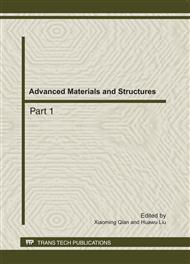[1]
Mao Wenyong, Wu Jianping, the Environment Problem and Countermeasure of the Global (in Chinese), Beijing: Chinese Science and Technology Press, 51, 1992.
Google Scholar
[2]
Collett T S, Ginburg G D. Gas hydrate in the Messoyakha gas field of the west Siberian basic-A extermination of the geologic evidence [A].in: Proceeding of 7th International Offshore and Polar Engineering Conference[C], 96-103, 1997.
Google Scholar
[3]
Dallimore S R, Uchida T, Collett T S. Scientific results from JAPEX/JNOC/GSC Mallik 2L 238 gas hydrate research well, Mackenzie Delta, Northwest Territories Canada. Geological Survey of Canada, Bulletin, 544, 1999.
DOI: 10.4095/210723
Google Scholar
[4]
Devidson D W, El-Defrawy M K, Fuglem M O. Natural gas hydrate in Northern Canada [A]. In: proceedings of 3rd International Conference on Permafrost (Volume1) [C]. Edmonton, Alberta, Canada, 938-943, 1978.
Google Scholar
[5]
Collett T S. Natural gas hydrates of the Prudhoe Bay and Kuparuk river area, North Slope, Alaska [J]. American Association of Petroleum Geologists Bulletin, 77(5):793-815, 1993.
DOI: 10.1306/bdff8d62-1718-11d7-8645000102c1865d
Google Scholar
[6]
Huang P, Pan G, Wang L. Predicted the gas hydrate resource of Qinghai-Tibet plateau [J]. Geological Bulletin of china, 21(11), 794-798, 2002.
Google Scholar
[7]
Xu X.Z, Cheng, G.D, Yu, Q.H. Research prospect and suggestions of gas hydrate in permafrost regions on the Qinghai-Tibet Plateau. [J]. Advance in earth sciences, 14(2), 201-204, 1999.
Google Scholar
[8]
Zhang L.X, Xu X.Z, Ma W. Permafrost and gas hydrate of Qinghai-Tibet Plateau. Natural gas geosciences. 12(1), 22-26, 2001.
Google Scholar
[9]
Liu H.S, Han X.L. Geophysical recognition and prediction of natural gas hydrate in Qiangtang basin of Tibet. Northwestern Geology. 37(4), 33-38, 2004.
Google Scholar
[10]
Cheng D.S, Li Y.T, Lei Z.Y. Characteristics of hydrocarbon generation in Qiangtang basin Qinghai-Tibet Plateau. Scientia Geologica Sinica. 35(4), 474-481, 2000.
Google Scholar
[11]
Wang Y.Y, Yun J.B, Teng Y.H. Discussion on geodynamic evolution and oil gas prospect of Qiangtang basin. Acta petrolei sinica. 20(3), 33-38, 1999.
Google Scholar
[12]
Tan F.W, Wang J, Wang X.L. The largest bituminous dike was discovered at Qiangtang basin of Northern Qinghai-Tibet Plateau. Geological bulletin of china. 21(11), 801-802, 2002.
Google Scholar
[13]
Du B.W, Tan F.W, Wang J. The discovery and significance of the large-scale asphalt veins in the Qiangtang Basin, northern Xizang. Sedimentary Geology and Tethyan Geology.2391), 69-74, 2003.
Google Scholar
[14]
Chen D.F, Wang M.C, Xia B. Formation condition and distribution prediction of gas hydrate in Qinghai-Tibet Plateau permafrost. Chinese J .Geophys. , 48 (1), 165-172, 2005.
DOI: 10.1002/cjg2.638
Google Scholar
[15]
Qiao YC, Zhao GP, Shi YL, et al.2010. Numerical Simulation of the Qinghai-Tibet Plateau Rising Rates Influence the Permafrost Formation. ACTA GEOLOGICA SINICA. 84(6): (in Chinese with English abstract)
Google Scholar
[16]
Lu Z Q, Wu B H, Rao Z, et al. Geological and geochemical anomalies possibly indicating gas hydrate occurrence in the permafrost zone along the Qinghai-Tibet railway. Geological Bulletin of China, 26 (8):1029-1040, 2007. (In Chinese)
Google Scholar
[17]
Lu Z Q, Sultan N. Empirical expressions for gas hydrate stability law, gas hydrate fraction and gas hydrate layer density at temperature 273. 15 K to 290. 15 K. Geochemical Journal, 42 (2): 163-175, 2008.
DOI: 10.2343/geochemj.42.163
Google Scholar
[18]
Lu Z Q, Sultan N, J in C S, et al. modeling on gas hydrate formation conditions in the Qinghai2Tibet plateau permafrost .Chinese J. Geophys. 52 (1):157-168, 2009.
Google Scholar
[19]
Song H B, Matsubayashi O, Yang S X, et al. Physical property models of gas hydrate bearing sediment s and AVA character of bottom simulating reflector. Chinese J .Geophysics. 45 (4): 569-579, 2002. (In Chinese)
DOI: 10.1002/cjg2.270
Google Scholar
[20]
Song H B , Jiang W W, Zhang W S , et al . Progress on marine geophysical studies of gas hydrate. Progress in Geophysics. 17 (2): 224-229, 2002. (In Chinese)
Google Scholar
[21]
Yi H S, Shi Z Q, Liu WJ, et al. The potential and prospect of gas hydrate in the Qinghai2Tibet plateau permafrost zone .Geology of Tibet, 2002 (1):45-52, 2002. (In Chinese)
Google Scholar
[22]
Wu Q B, Jiang G L, Pu Y B, et al. Relationship between permafrost and gas hydrate on Qinghai-Tibet Plateau .Geological Bulletin of China, 25 (1):29-33, 2006. (In Chinese)
Google Scholar


